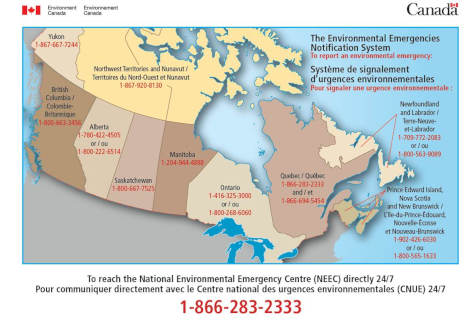Environmental Disaster Strikes… Now What?
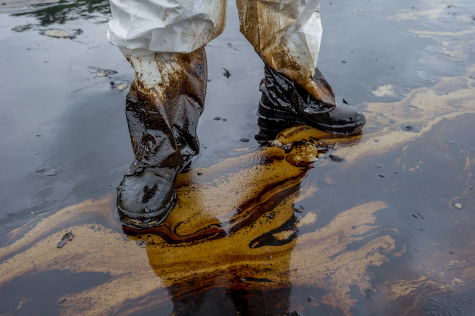
By Jacquelyn Stevens and Candice Gomes
Willms & Shier Environmental Lawyers LLP

You have dreaded this day, and you did what you could to prevent it, but it has come, nonetheless. An environmental incident has occurred (or just been discovered).
So, what happens next?
This article will set out a non-exhaustive “checklist” of steps to take and considerations to make, before and after a disaster strikes.
A. Before a Disaster

Dry cleaners operate from a very unique position as businesses that frequently employ the use of complex machinery and chemicals. Accordingly, this leaves some dry cleaning operations vulnerable in the event of an incident or accident.
For example, to ensure you are conducting your business in a responsible way, you should:
- ensure that your operations are in accordance with federal, provincial and municipal laws
- ensure your operations have the correct setup, for example, a Tetrachloroethylene/ Perchloroethylene (“PERC’) impermeable floor drain plug and sufficient/well-maintained ventilation
- maintain and inspect all dry cleaning equipment frequently
- ensure employees, and all others associated with the business, are sufficiently trained:
- on business operations,
- proper labeling, and
- proper handling of chemicals
- ensure the prevention of leaks and spills of any chemicals kept on the dry cleaning property
- ensure that there are proper containers and containment systems available to prevent a potential environmental disaster, and
- ensure that materials are safely disposed.
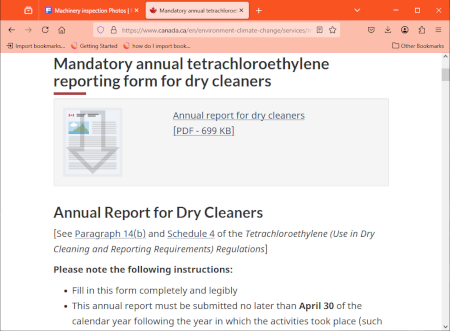
Notably, some dry cleaners also have clear reporting requirements to meet, particularly for operations that use PERC. For example, the Mandatory Annual Tetrachloroethylene Reporting Form for Dry Cleaners.1 Further, the government offers a great deal of compliance information for dry cleaning owners and operators 2 and even sets out its own checklist for dry cleaners using PERC.3
Additionally, it is imperative that businesses have sufficient plans in place. Not only do plans prevent environmental emergencies before they happen, but they can provide guidance if disaster strikes.
Proactive planning for dry cleaning operations should include:
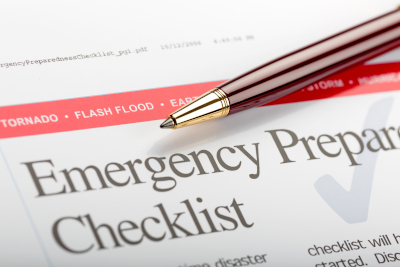
- identification of the primary contact for emergency reporting
- an emergency response plan – with emergency contact numbers for fire, police, spills reporting and the municipality, other essential contact information, lists of and locations for emergency equipment and personal protective equipment, first aid measures, and procedures for cleanup
- the Canadian Centre for Occupational Health and Safety has also put together an Emergency Response Planning Guide to help prepare businesses generally, in case of emergency 4
- a spill response plan – with information about chemical use, health effects, first aid measures, spill kit location and use, a spill reporting protocol, instructions for spill cleanup, and cleanup procedures
- a waste management plan – with waste handling and storage procedures, waste handling records, storage and disposal processes, reputable waste management organization contacts to transport and dispose of waste, and waste haulers and receivers with necessary environmental approvals (don’t forget to spot check approvals and compliance of your suppliers periodically)
- a maintenance and inspection schedule – which identifies and schedules daily, weekly, monthly, semi-annual and annual maintenance and inspections for all machinery, records dates and details of inspections, maintenance and repairs, and
- machinery operating procedures and policies – with standard machinery operating procedures and policies to be followed by all employees (ensuring that all employees are properly trained).
Planning can also help in the face of regulatory or civil litigation. For example, if faced with regulatory charges or a lawsuit, comprehensive and robust emergency management planning can assist in due diligence defences to demonstrate that a business took all possible steps to prevent an incident from occurring.
B. Disaster strikes — What are the immediate next steps for environmental emergencies?
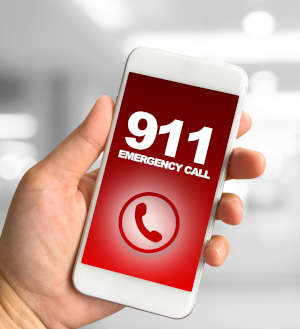
In the immediate aftermath of an environmental incident, the first step is to contact emergency services, and ensure that any immediate medical needs are attended to.
The next step is for employees and/or management onsite to notify authorities “forthwith” (in Ontario 5) and “as soon as possible in the circumstances” (federally) about the environmental emergency.6 It is not sufficient to report to one authority and not another, where otherwise required to do so. This guidance comes from a Supreme Court of Canada decision highlighted later in this article.
Generally, there is a requirement to report where there is a:
- discharge, spill, or release into the environment,
- of a contaminant, pollutant, or substance,
- that has caused or may cause an adverse effect.
- Adverse effects can include:
- impairment of the quality of the natural environment
- injury or damage to property or to plant or animal life
- harm or material discomfort to any person
- an adverse effect on the health of any person
- impairment of the safety of any person,
- rendering any property or plant or animal life unfit for human use
- loss of enjoyment of normal use of property, or
- interference with the normal conduct of business 7
Who must report (Ontario)?
In Ontario, every person who discharges into the natural environment, or who is the person responsible for a source of contaminant that discharges into the natural environment, any contaminant in an amount, concentration or level in excess of that prescribed by the regulations, shall forthwith notify the Ministry of the Environment, Conservation and Parks (“MECP”) of the discharge.8

Further, every person who discharges a contaminant or causes or permits the discharge of a contaminant into the natural environment shall forthwith notify the MECP, if the discharge is out of the normal course of events, the discharge causes or is likely to cause an adverse effect and the person is not otherwise required to notify the MECP.9
Additionally, every person having control of a pollutant that is spilled and every person who spills or causes or permits a spill of a pollutant shall forthwith notify several entities including the MECP, the municipality where the spill occurred, and anyone who is the owner or person in control of the pollutant.10
Finally, any member of a police service or employee of a municipality or other public authority who is informed of or who investigates the spill of a pollutant shall forthwith notify the MECP of the spill of the pollutant.11
Who must be informed?
Generally, the following entities should be informed in the event of an environmental emergency:
- Your provincial/territorial emergencies/spill centre, for example, in Ontario the emergency contact is the Spills Action Centre at 1-866-MOE-TIPS (663-8477), 12
- Environment and Climate Change Canada may also need to be informed 13
- your provincial/territorial environmental regulatory authority
- the municipality within which the incident took place
- the “Owner” or person in control of the pollutant
- any person who may be directly affected
Is a phone call enough?
While a phone call may be your first (and only) instinct for reporting, in some jurisdictions, written reports are required. The Fisheries Act, which is federal legislation, requires a written report “as soon as feasible after the occurrence. 14
Another example of required written notice comes out of Alberta, where the Environmental Protection and Enhancement Act requires that a written report be submitted to the appropriate Alberta Environment and Parks Director within seven days after the immediate/initial report. 15
Is a report required?
In some jurisdictions, there may be no requirement to report because of an exemption. For example in Ontario, if a spilled substance is part of a spills prevention and contingency plan, if the volume of a spill meets a small quantities exemptions, or if there is no prospect of the spilled material entering the environment and causing an adverse effect, there may not be a requirement to report at all.16
However, it is advisable that reporting is undertaken, to ensure that all possible actions were taken to limit an incident’s negative impacts to the environment and health.
What should be included in a report?
- your name, role, organization and contact information
- description of incident/spill – product(s) and quantity
- description of circumstances leading up to the release
- date/location of incident/spill
- duration of the incident/spill and whether continuing
- cause or most likely cause of the incident/spill
- when the incident/spill occurred (or was discovered)
- details of action taken/proposed to be taken in response
- departments/organizations informed or at the site
C. After the dust settles
Contact legal representatives to help navigate the process if an inspection/investigation has been commenced by a regulatory authority to determine what happened in the course of the event and what the next steps are with the forthcoming inspection/investigation.
Why must these steps be taken?

There are several pieces of legislation which mandate reporting a spill or emergency, such as the Canadian Environmental Protection Act, 1999, at the federal level, and the Environmental Protection Act, 1990 in Ontario.
Moreover, there are several cases, in Ontario and in Canada more broadly where a failure to report quick enough, or not reporting to all requisite authorities, was enough for the offending party to face steep penalties:
- R v Dofasco (Ontario, 2020)
A spill occurred in Hamilton Harbour and Dofasco took time to investigate/remediate prior to reporting. The Court held that 3.5 hours was too long to wait to report, and Dofasco was fined $60,000 (with an additional 25% Victim Fine Surcharge).
- R. v. Shell Canada Ltd., 2000 ABQB 459 (CanLII)
A report indicating toxicity of a discharge was mailed to Shell, but the employee who received the report filed it without reading it. It was eventually reported 2 weeks later. The failure to report turned on the wording of the legislation and reporting “immediately upon becoming aware” that the release has caused, is causing, or may cause an adverse effect. The employee only had knowledge of the report, but not actual knowledge of the adverse effect. The Crown was unable to prove the act of failing to report and was not aware of the adverse effects until the report was read.
- Castonguay Blasting Ltd. v. Ontario (Environment), 2013 SCC 52 (CanLII), [2013] 3 SCR 323]
A blasting operation went wrong and rock debris (i.e., fly-rock) was sent into the air and damaged a nearby home. The Ministry of Transportation and Ministry of Labour was contacted, but not the Ministry of Environment. The failure to report to the Ministry of the Environment resulted in a fine of $25,000. Ultimately, the Supreme Court of Canada stated: “when in doubt, report”.
Key Takeaways
First, it is important to prepare and implement robust emergency plans and proactive safety practices to: (i) prevent or reduce the risk of incidents occurring, (ii) eliminate or ameliorate adverse effects of an incident, and (iii) demonstrate the capacity to effectively respond to a spill. Doing more robust work ahead of an emergency can make the process of navigating one far more manageable, and may have material benefits in the face of litigation and regulatory enforcement.
Second, it is important to act fast when disaster strikes, taking steps to ensure safety and containment of the disaster where possible, including appropriate reporting. This stage is key to ensure requirements are met from a legal perspective so that you and your business remain onside of the law.
Finally, you may consider contacting legal professionals who can help navigate any possible legal action, because despite your best efforts, incidents can lead to unpredictable outcomes and decisive actions can help quell any concerns… when disaster strikes.
Jacquelyn Stevens is a Partner with Willms & Shier Environmental Lawyers LLP in Toronto and is certified as a Specialist in Environmental Law by The Law Society of Ontario. Jacquie may be reached at 416-862-4828 or by e-mail at jstevens@willmsshier.com.
Candice Gomes is an Articling Student at Willms & Shier Environmental Lawyers LLP in Toronto. Candice may be reached at 416-642-4875 or by e-mail at cgomes@willmsshier.com.
The information and comments herein are for the general information of the reader only and do not constitute legal advice or opinion. The reader should seek specific legal advice for particular applications of the law to specific situations.
FOOTNOTES
1 Government of Canada, “Mandatory annual tetrachloroethylene reporting form for dry cleaners” (14 January 2025), online here: Government of Canada .
2 Government of Canada, “Compliance information for dry cleaning owners and operators: Tetrachloroethylene (PERC) regulations” (12 September 2024), online here: Government of Canada.
3 Government of Canada, “Checklist for dry cleaners using PERC” (16 January 2023), online here: Government of Canada.
4 Canadian Centre for Occupational Health and Safety, “Emergency Response (Revised)” (2020), online (pdf) here.
5 Environmental Protection Act, RSO 1990, c E19 s. 15(1); 92(1).
6 Canadian Environmental Protection Act, 1999 SC 1999, c 33 s 201(1).
7 Supra note 5 at s 1.
8 Supra note 5 at s 13(1).
9 Supra note 5 at s 15 (1).
10 Supra note 5 at s 92 (1).
11 Supra note 5 at s 92 (4).
12 Government of Ontario, “Report pollution and spills” (30 August 2021), online here: Government of Canada.
13 Government of Canada, “Report an environmental emergency” (13 September 2023), online here: Government of Canada.
14 Fisheries Act, RSC, 1985, c F-14 s 38(7).
15 Government of Alberta, “A Guide to Release and Reporting” (nd) at 6, online (pdf) here: Government of Alberta .
16 O Reg 675/98, s 10.

